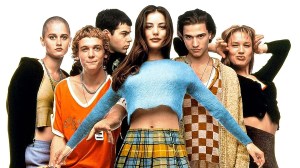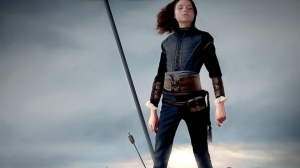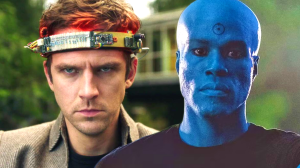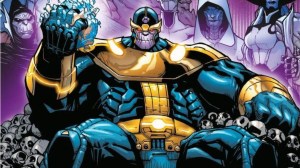Filmmaker Henry Selick made his feature-film debut with the now-iconic The Nightmare Before Christmas, collaborating closely with Tim Burton to bring the macabre and whimsical experience to life. The film quickly earned a passionate following, thanks to Selick’s innovative directing style, with the filmmaker similarly developing a stop-motion masterpiece in 2009 with Coraline, based on a story by Neil Gaiman. The filmmaker’s latest project, Netflix’s Wendell & Wild, once again sees Selick teaming up with a master storyteller, this time working with Jordan Peele to deliver a creepy yet comedic adventure. Wendell & Wild hits Netflix on October 28th.
Videos by ComicBook.com
From the delightfully wicked minds of Henry Selick and producer Jordan Peele, comes Wendell & Wild, an animated tale about scheming demon brothers Wendell (Keegan-Michael Key) and Wild (Peele) — who enlist the aid of Kat Elliot — a tough teen with a load of guilt — to summon them to the Land of the Living. But what Kat demands in return leads to a brilliantly bizarre and comedic adventure like no other, an animated fantasy that defies the law of life and death, all told through the handmade artistry of stop motion.
ComicBook.com caught up with Selick to talk developing the film, its most challenging sequences, and weighs in on a debate among fans about his classic film.

ComicBook.com: You have this legacy, this impressive body of work when it comes to stop-motion animation, and I know you’ve talked about how some studios or some productions might encourage a CG route and that is not your thing, not your passion. With Wendell & Wild, do you make it an active choice to do things with the animation that you couldn’t do with CG?
Henry Selick: Well, CG animation, it really could do anything. In some cases, people have used it to try to make it look like stop-motion because that was a look they wanted.
The main thing for me is we want to differentiate it and so we keep the imperfections. For the facial animation where we literally have different expressions for every single face, it is changed out for speaking, to show anger or happiness. We use an upper and lower face, I left the seam lines in between those faces. We leave in some of the smaller mistakes.
My mission is, if we’re going to do stop-motion, let’s make sure people see that, that charm, that warmth, because that’s something CG wouldn’t do. They wouldn’t bother because the goal of CG is perfection, and if you have got a great story with the perfection, that’s going to work, but that’s not my interest or the interest of the people I work with.
There’s a wide range of emotions in this film, but then there’s also demons and these incredible landscapes with high-octane action sequences. When it comes to stop-motion animation, is the bigger challenge those more nuanced, emotional facial expressions or is it the 1,000 moving pieces of a complex action scene?
You’ve pretty much zeroed in on the two biggest challenges. That up-close performance of a protagonist like Kat, we want our very best animators to be doing those. When you go in for a closeup, it’s very hard to convince the audience to believe in what is essentially a puppet emoting, so those are great challenges, as well as the multi-character, big action sequences where you’re juggling so many elements. There’s usually going to be large sets, big camera moves, and how do we get it all to read? How do we not just have a big mess of moving stuff?
So you nailed it. Those are the two things that are the most difficult, and the rest aren’t easy either, but they’re easier.
A thing that I love specifically about Wendell & Wild that I feel sets it apart, not just from your other projects, but just from other animated projects out there, is the musical choices. As a fan of X-Ray Spex, the significance of them, and the inclusion of Death in there, some bands that I’m a big fan of. What was that process like? Were those bands, were those musical selections, were those baked into the script? Were those from you, were those from Jordan? Were there some options that were tested that maybe didn’t play as well?
I’m really happy with where we ended up. It wasn’t baked in from the beginning. There’s a couple of key things I’d share.
One was we wanted a look for Kat that was unique, something a little different. Jordan and I came upon this cultural movement, this musical movement called “afropunk.” It’s about 10 years old at this point, and it’s mainly young people celebrating the roots of Black punk music, which goes back to the ’70s and ’80s, and then with an amazing sense of fashion, African-inspired colors. But it’s not a pure thing. It’s a reinvention of punk, very colorful. It’s nothing like the goth movement. Then having some of the old acts perform at these festivals and then new punk people or punk-adjacent people like Janelle Monáe, so it started as just a look for Kat and then the music that goes along with that.
Then it became a connection to her dad. She has dad’s old boombox, she has dad’s mix tapes. What were on those mix tapes? So that led directly to first-gen Black and brown punk bands. You’d be surprised that I’m not a complete stranger to that because, in 1985, I directed a music video for a band called Fishbone, which was a punk-funk band. Through them, I was aware of these other early punk bands who, they may have extreme names, but their music is actually somewhat melodic and beautiful and really stands the test of time, compared to some of the other harsh punk bands of the time.
But as far as picking the songs, I had some ideas, Jordan did, and part of his team members, this guy Win Rosenfeld, he had a lot of great ideas. We got really good ideas from Netflix, from Brandon Coulter, from an executive, Karen Toliver who came in late in the game. My editor, Mandy Hutchings, she always found the very best.
It became very collaborative and it was really fun to pick what’s the right song for this moment, for this character. That’s a long story, it was a long answer, but I’m really happy where it ended up.
I look forward to a stop-motion animation biopic about Bad Brains or something for the next project.
Lastly here, I do have to bring it up. I do have to ask, it’s the time of year when fans on the internet, they like to debate if they think The Nightmare Before Christmas is a Christmas movie or a Halloween movie and I know that it’s both. Chris Sarandon, I asked him the same thing and he said, “It’s both. What are you talking about?” Do you personally, when you reflect on your experience of making that movie, did you view it as more of one than the other or do you think it’s totally 50-50, however you enjoy it, that’s the right answer?
At the very beginning, when Tim Burton came up with this original idea in the ’80s at Disney, when it was intended to be a half-hour TV special in stop-motion, at the very beginning, I saw it as a mashup, that it’s both.
Then, subsequently, when we actually made the film as a feature, I might have tended to answer one way, but I’ve arrived at the original feeling. It is a mashup. It is a perfect collision between those two holidays. So there’s no better answer than both. It is both, and it’s its own thing. It’s a great celebration of Halloween that can last all the way into Christmas.
To get a movie that is just as appropriate in September, October, November, and December, as well as all year, that’s definitely a pretty impressive feat for you to pull off with a movie.
It seems to work. People are still watching it.
Wendell & Wild hits Netflix on October 28th.
This interview has been edited for length and clarity. You can contact Patrick Cavanaugh directly on Twitter.








